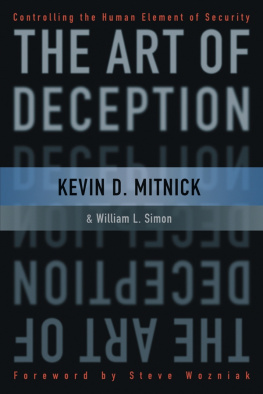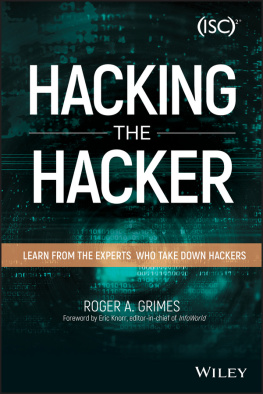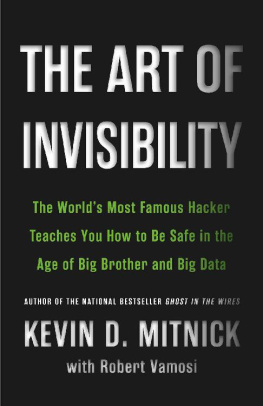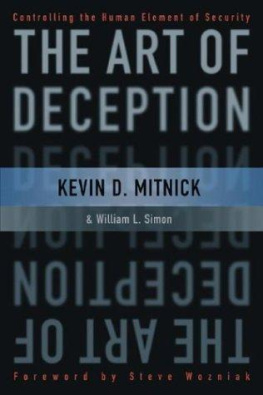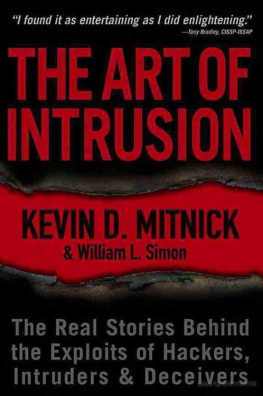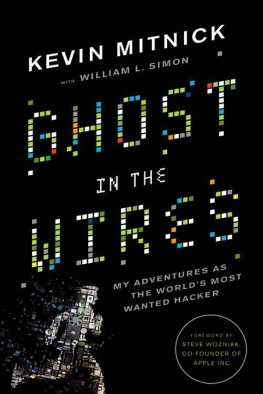Table of Contents
Vice President & Executive Group Publisher: Richard Swadley
Vice President and Executive Publisher: Bob Ipsen
Vice President and Publisher: Joseph B. Wikert
Executive Acquisitions Editor: Carol Long
Development Editors: Emilie Herman, Kevin Shafer
Editorial Manager: Kathryn Malm Bourgoine
Senior Production Editor: Angela Smith
Project Coordinator: April Farling
Copy Editor: Joanne Slike
Interior Design: Kathie S. Rickard
Text Design & Composition: Wiley Composition Services
Published by
Wiley Publishing, Inc.
10475 Crosspoint Boulevard
Indianapolis, IN 46256
www.wiley.com
Copyright 2005 by Kevin D. Mitnick and William L. Simon
Published by Wiley Publishing, Inc., Indianapolis, Indiana
Published simultaneously in Canada
No part of this publication may be reproduced, stored in a retrieval system or transmitted in any form or by any means, electronic, mechanical, photocopying, recording, scanning or otherwise, except as permitted under Sections 107 or 108 of the 1976 United States Copyright Act, without either the prior written permission of the Publisher, or authorization through payment of the appropriate per-copy fee to the Copyright Clearance Center, 222 Rosewood Drive, Danvers, MA 01923, (978) 750-8400, fax (978) 646-8600. Requests to the Publisher for permission should be addressed to the Legal Department, Wiley Publishing, Inc., 10475 Crosspoint Blvd., Indianapolis, IN 46256, (317) 572-3447, fax (317) 572-4355, e-mail: brandreview@wiley.com.
Limit of Liability/Disclaimer of Warranty: The publisher and the author make no representations or warranties with respect to the accuracy or completeness of the contents of this work and specifically disclaim all warranties, including without limitation warranties of fitness for a particular purpose. No warranty may be created or extended by sales or promotional materials. The advice and strategies contained herein may not be suitable for every situation. This work is sold with the understanding that the publisher is not engaged in rendering legal, accounting, or other professional services. If professional assistance is required, the services of a competent professional person should be sought. Neither the publisher nor the author shall be liable for damages arising herefrom. The fact that an organization or Website is referred to in this work as a citation and/or a potential source of further information does not mean that the author or the publisher endorses the information the organization or Website may provide or recommendations it may make. Further, readers should be aware that Internet Websites listed in this work may have changed or disappeared between then this work was written and when it is read.
For general information on our other products and services please contact our Customer Care Department within the United States at (800) 762-2974, outside the United States at (317) 572-3993 or fax (317) 572-4002.
Trademarks: Wiley and the Wiley logo are trademarks or registered trademarks of John Wiley & Sons, Inc. and/or its affiliates, in the United States and other countries, and may not be used without written permission. All other trademarks are the property of their respective owners. Wiley Publishing, Inc., is not associated with any product or vendor mentioned in this book.
Wiley also publishes its books in a variety of electronic formats. Some content that appears in print may not be available in electronic books.
Library of Congress Cataloging-in-Publication Data:
Mitnick, Kevin D. (Kevin David), 1963-
The art of intrusion : the real stories behind the exploits of hackers, intruders, and deceivers / Kevin D. Mitnick, William L. Simon.
p. cm.
Includes index.
eISBN : 978-0-471-46994-0
1. Computer security. 2. Computer hackers. I. Simon, William L., 1930- II. Title.
QA76.9.A25M587 2005
005.8--dc22
2004025697
For Shelly Jaffe, Reba Vartanian, Chickie Leventhal,
Mitchell Mitnick
For Darci and Briannah
And for the late Alan Mitnick, Adam Mitnick,
Sydney Kramer, Jack Biello.
For Arynne, Victoria, Sheldon, and David, and for Vincent and
Elena
Preface
Hackers play one-up among themselves. Clearly one of the prizes would be bragging rights from hacking into my security companys Web site or my personal system.
Another would be that they had made up a story of a hack and planted it on me and my co-author Bill Simon so convincingly that we were taken in, believed it as true, and included it in this book.
That has presented a fascinating challenge, a game of wits that the two of us have played time after time as we did the interviews for the book. For most reporters and authors, establishing authenticity is a fairly routine matter: Is this really the person he or she claims to be? Is this person or was this person really working for the organization he or she claims? Did this person have the position he or she says? Does this person have documentation to back up the story, and can I verify that the documents are valid? Are there reputable people who will support the story or parts of it?
With hackers, checking the bona fides is tricky. Most of the people whose stories appear in this book, other than a few who have already been to prison, would face felony charges if their true identities could be determined. So, asking for real names, or expecting to be offered as proof, is an iffy proposition.
These people have only come forward with their stories because they trust me. They know Ive done time myself, and they are willing to rely on my not betraying them in a way that could put them in that position. Yet, despite the risks, many did offer tangible proof of their hacks.
Even so, its possible in fact, its likely that some people exaggerated their stories with details intended to make them more compelling, or spun a story that was a total fabrication, but constructed around enough workable exploits to give them the ring of truth.
Because of that risk, we have been diligent in holding to a high standard of reliability. Through all the interviews, I have challenged every technical detail, asking for in-depth explanations of anything that didnt sound quite right, and sometimes following up later to see if the story was still the same or if he or she told it differently the second time around. Or, if this person couldnt remember when asked about some hard-to-accomplish step omitted from the story. Or, if this person just didnt seem to know enough to do what he or she claimed or couldnt explain how he or she got from point A to point B.
Except where specifically noted, every one of the main stories in this book has passed my smell test. My co-author and I agreed on the believability of every person whose story we have included. Nevertheless, details have often been changed to protect the hacker and the victim. In several of the stories, the identities of companies are disguised. I modified the names, industries, and locations of targeted organizations. In some cases, there is misleading information to protect the identity of the victim or to prevent a duplication of the crime. However, the basic vulnerabilities and nature of the incidents are accurate.
At the same time, because software developers and hardware manufacturers are continually fixing security vulnerabilities through patches and new product versions, few of the exploits described in these pages still work as described here. This might lead the overconfident reader to decide that he or she need not be concerned, that, with vulnerabilities attended to and corrected, the reader and his or her company have nothing to be worried about. But the lesson of these stories, whether they happened six months ago or six years ago, is that hackers are finding new vulnerabilities every day. Read the book not to learn specific vulnerabilities in specific products, but to change your attitudes and gain a new resolve.


